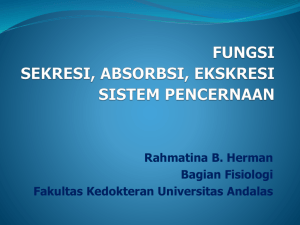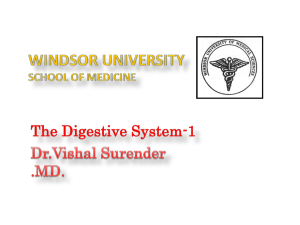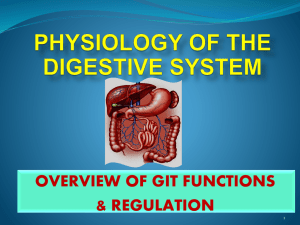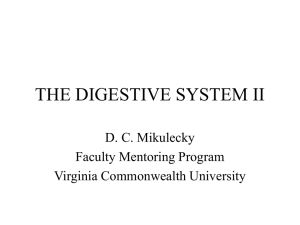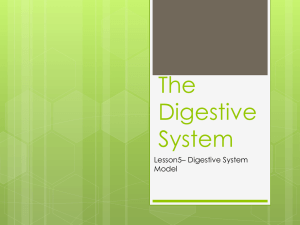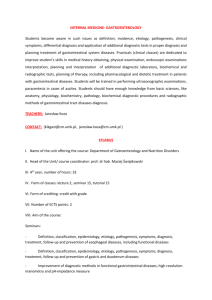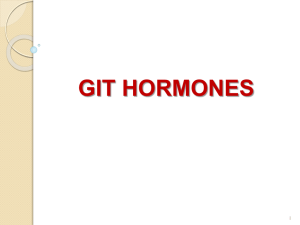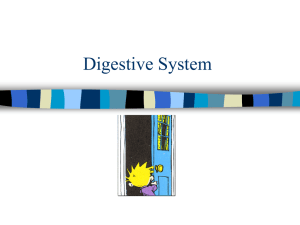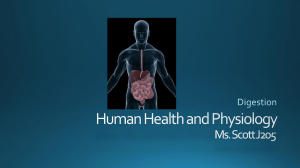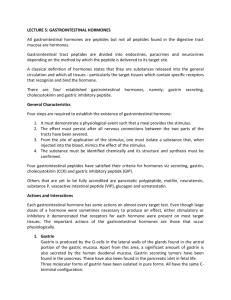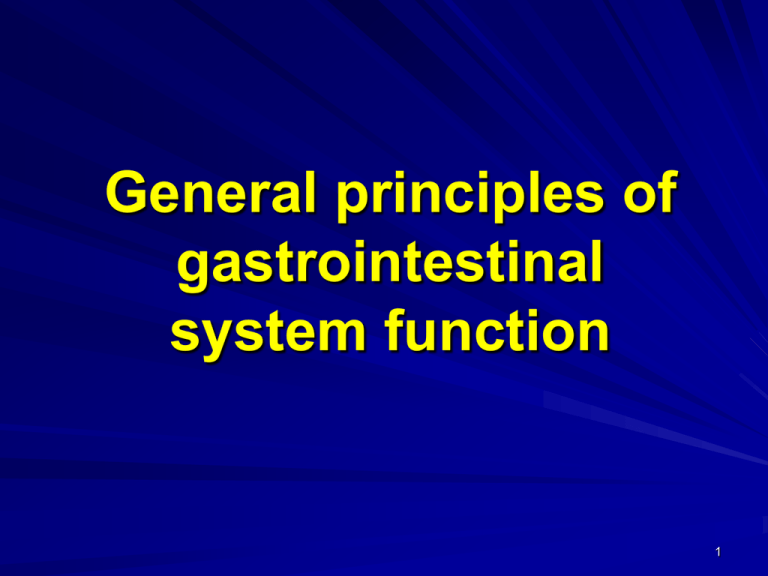
General principles of
gastrointestinal
system function
1
Objectives
List the main functions of the digestive system.
Define the terms: ingestion, digestion, absorption,
motility, secretion.
Outline the basic processes performed by the
digestive system.
Describe the role of autonomic nervous system on
GIT function.
Describe the innervations and the neural control of
the gastrointestinal tract.
Describe the role of enteric nervous system in
control of gastrointestinal function.
List the types of motor activity of the gastrointestinal
tract.
List the main functions of the GI hormones.
List factors affecting gastrointestinal secretion and
motility.
2
Gastrointestinal System
Gastrointestinal tract
( continues tube that
extends from the mouth to
the anus)
Accessory digestive
organs
( teeth, tongue, salivary
glands, liver, gallbladder,
and pancreas)
3
Functions of Gastrointestinal
System
Absorption of nutrients, water and
electrolytes
Excretion of waste products
Endocrine functions
Immune functions
4
General Principles of Gastrointestinal
System
Supply the body with water, electrolytes and
nutrients.
To achieve this it:
1. Moves food through the alimentary tract
(motility).
2. Secretes digestive juice to digest food (Secretion
and digestion)
3. Absorbs the digestive products (absorption)
ALL these functions are under
nervous and hormonal regulation
5
Functions of the digestive system
Ingestion
Taking food and liquids into the
mouth
Secretion
Cells within the walls of the GI tract and
accessory digestive organs secrete
around 7 liters of water, acid, buffers
and enzymes into the lumen of the
tract.
6
Functions of the digestive system
cont…
Mixing and propulsion
Alternating contraction and relaxation of smooth muscles in the wall
of the GI tract. It mixes the food with secretions and propel it
towards the anus (motility)
7
Functions of the digestive system
cont…
Digestion
Mechanical:
Teeth= breaking down the food into small parts
before it is swallowed
Smooth muscles = churning of food
Chemical ( enzymes) :
large carbohydrate, lipid, protein and nucleic
acids in the food are split into smaller
molecules
8
Functions of the digestive system
cont…
Absorption:
The entrance of ingested and secreted fluids, ions, and
small molecules into the epithelial cells lining the
lumen of the GI tract. The absorbed substances pass
into blood or lymph and circulate to cells throughout
the body
9
Functions of the digestive system
cont…
Defecation:
Elimination of wastes, indigestible substances, bacteria,
cells sloughed from the lining of the GI tract, and
digested materials that were not absorbed through
the anus.
10
Neural Regulation of the GIT
functions
1.Enteric Nervous system
2.Autonomic Nervous System
(Extrinsic GIT Innervations)
11
1. Enteric Nervous system
The intrinsic nerves make up a very dense
network embedded in the walls of the
esophagus, stomach, small intestine, and
colon.
12
13
Extrinsic GIT Innervations
Sympathetic:
– Arises from thoracic and upper lumber
spinal cord (T5-L2).
– Pre-ganglionic fibers synapse outside GI
tract in pre-vertebral ganglia
– Post-ganglionic adrenergic fibers
innervate the cells of the myenteric and
submucosal plexus
– Elements from the two plexuses innervate
the smooth muscle, secretory and
endocrine cells.
– The postganglionic neurotransmitter is
mainly Epinephrine (adrenaline).
–
Increase of sympathetic nerve activity →
inhibitory effects, e.g. ↓secretion, ↓
motility and ↓ blood flow.
14
Parasympathetic:
The dorsal motor nucleus of the vagus
supplies efferent vagus nerve fibers
to:Lower esophagus, Stomach, Small
intestine and Proximal colon
The sacral outflow arises from
neurones in the sacral spinal code (S2S4)→ pelvic nerve → innervation of the
distal colon, rectum and anal canal.
Pre-ganglionic fibers synapse with
ganglionic cells located in the enteric
nervous system.
The preganglionic neurotransmitter is
mainly Acetylcholine.
Increase of parasympathetic nerve
activity → Stimulatory effects, e.g.
↑gastric, pancreatic and small intestinal
secretion, ↑ blood flow and muscle
contraction.
15
4. Hormonal regulation
Gastrin
Cholesystokinin (CCK)
Secretin
GIP (Gastric Inhibitory Peptide)
Motilin
Somatostatin
Histamine
VIP (Vasoactive Intestinal Peptide)
GRP (Gastrin Releasing Peptide)
NO (Nitric Oxide)
16
GIT Hormones
• Gastrin (from antrum): increase acid secretion
• Cholesystokinin (CCK, Duodenum): causes gallbaldder
contraction and pancreatic secretion
• Secretin: inhibits acid secretion and stimulates pancreatic HCO3secretion
• GIP (Gastric Inhibitory Peptide): reduces gastric motility and
stimulates insulin secretion
• Motilin: increases GI motility & stimulate the production of pepsin
17
Neurocrines
• VIP (Vasoactive Intestinal Peptide): relaxes GI smooth muscle cells
• GRP (Gastrin Releasing Peptide, also called Bombesin): mediates
release of hormone Gastrin
• NO (Nitric Oxide): relaxes smooth muscle cells
• Enkephalins: contract sphincters
18
Summary of the pathway controlling digestive system
activities
Mechanoreceptors
Chemoreceptors
Osmoreceptors
19


